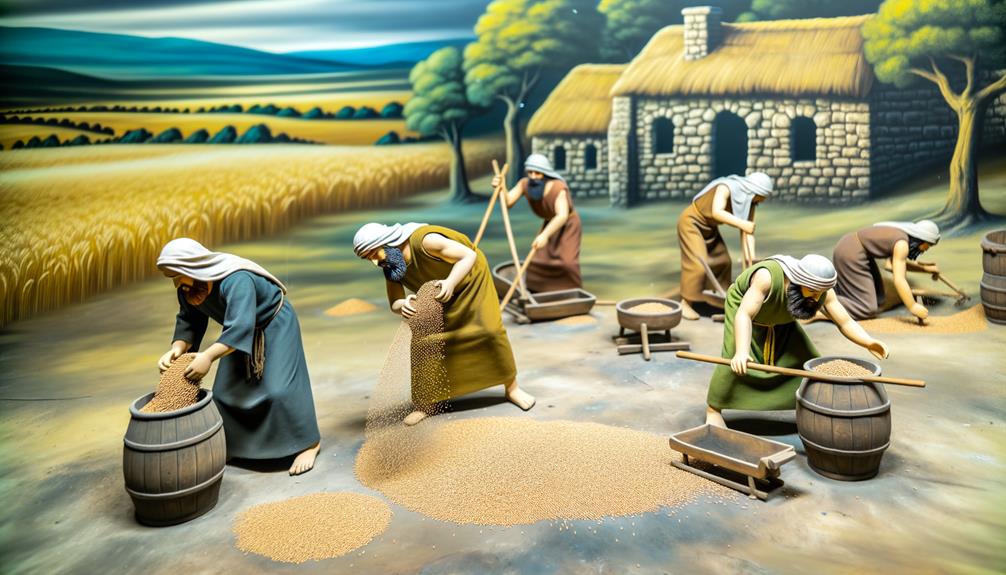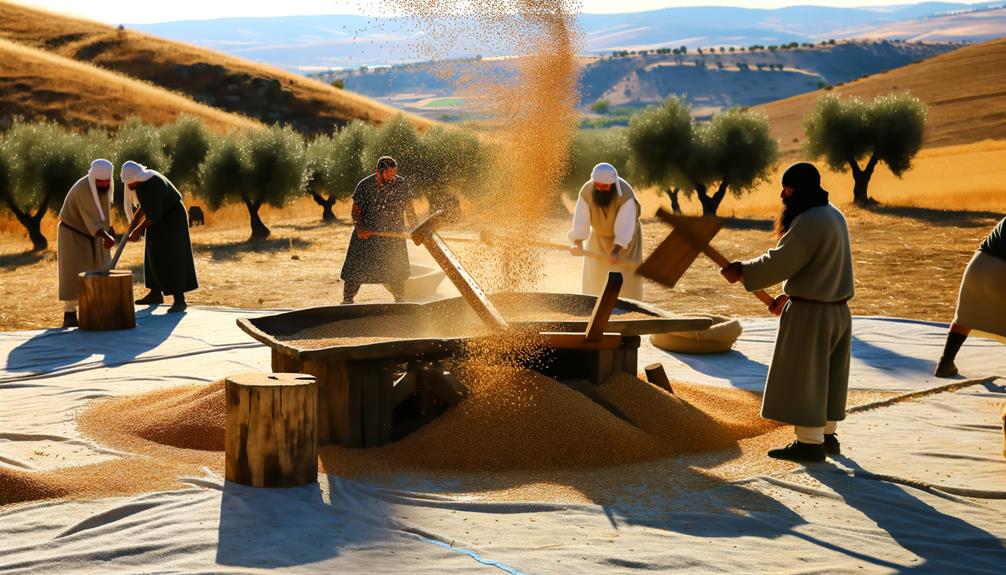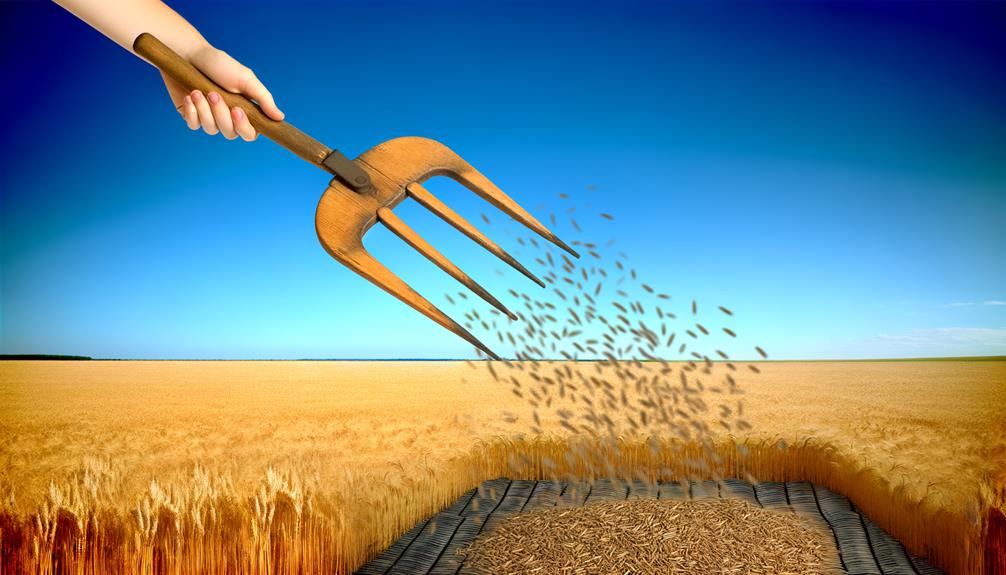Winnows Meaning In The Bible: Separation and Purification
In the Bible, ‘winnows‘ refers to the agricultural process of separating grain from chaff, widely practiced in ancient Israel. This concept holds profound theological significance, symbolizing divine judgment and the purification of believers.
Old covenant scriptures like Jeremiah 15:7 and Isaiah 41:16 depict winnowing as God’s method of separating the righteous from the wicked. In the New covenant, figures like John the Baptist employ this imagery to describe eschatological judgment (Matthew 3:12).
This vivid symbol underscores spiritual readiness and moral discernment, illustrating deeper truths about divine justice and sanctification. Engage further to uncover more layers of this biblical metaphor.

Winnows Meaning in the Bible: Symbolism of Separation and Purification
| Aspect | Details |
|---|---|
| Term Definition | To separate grain from chaff using wind or shaking |
| Biblical References | Matthew 3:12, Isaiah 41:16, Jeremiah 15:7 |
| Symbol of | Divine judgment, purification, and discernment |
| Spiritual Insight | Reflects the process of refining character and faith |
| Used To Represent | Separation of true believers from hypocrites or the unrighteous |
| Moral Message | Encourages spiritual integrity and readiness for judgment |
| Theological Implication | God’s active role in refining and preparing His people |
Historical Context of Winnowing

In the historical context of ancient Israel, winnowing was an essential agricultural process that involved separating the grain from the chaff, a practice frequently mentioned and symbolically significant in the Bible. This labor-intensive task was vital for ensuring the purity and quality of harvested grain, which formed the staple diet of the Israelite community.
The process typically took place on a threshing floor, where, after threshing, the mixture of grain and chaff was tossed into the air, allowing the wind to blow away the lighter chaff while the heavier grain fell back to the ground.
Theologically, winnowing serves as a powerful metaphor in Scripture, illustrating divine judgment and the separation of the righteous from the wicked, underscoring the importance of purity and discernment.
Winnowing in Old Testament

Scriptural references to winnowing in the Old Scriptures reveal its profound theological significance, often portraying it as a divine instrument for judgment and purification. The act of separating grain from chaff symbolizes God’s discerning judgment and His ability to distinguish the righteous from the wicked.
This metaphor is frequently employed to communicate themes of divine justice and the refining process of sanctification.
- Jeremiah 15:7: Depicts God winnowing His people as a form of judgment.
- Isaiah 41:16: Highlights the scattering of enemies like chaff before the wind.
- Ruth 3:2: Mentions the practice of winnowing during barley harvest, providing historical context.
Such references are essential for understanding divine justice in the Old Covenant.
Winnowing in New Testament

In the New Covenant, the concept of winnowing is prominently illustrated by John the Baptist’s metaphor, which underscores a divine act of discerning the righteous from the unrighteous (Matthew 3:12).
This theme of spiritual separation is further embodied in Jesus’ parables, such as the Wheat and the Tares (Matthew 13:24-30), highlighting the eschatological judgment.
Through these scriptural narratives, winnowing transcends its agricultural roots to symbolize the ultimate purification and judgment at the end of times.
John the Baptist’s Metaphor
Employing the agricultural imagery familiar to his audience, John the Baptist uses the metaphor of winnowing to vividly convey the impending judgment and separation of the righteous from the wicked in his proclamation of the coming Messiah.
This metaphor, found in Matthew 3:12 and Luke 3:17, encapsulates the purifying and discerning role of Christ. Historically, winnowing involved tossing grain into the air to separate the valuable kernels from the worthless chaff, symbolizing divine judgment and moral discernment.
- Scriptural Insight: Reflects God’s omniscience in discerning true faith.
- Theological Expertise: Highlights themes of repentance and divine justice.
- Historical Context: Resonates with first-century agrarian society.
This imagery underscores the gravity and urgency of spiritual preparedness.
Spiritual Separation Symbolism
Drawing upon the metaphorical language of winnowing, the New Scripture further elucidates the concept of spiritual separation, emphasizing the discernment and judgment inherent in Christ’s mission.
In the New Covenant, winnowing is employed to depict the sifting of the righteous from the unrighteous, particularly in apocalyptic contexts. For instance, in Matthew 3:12, John the Baptist describes Jesus as the one whose ‘winnowing fork is in his hand,’ signifying His role in divine judgment.
Historically, this imagery resonated deeply with the agrarian society, underscoring the necessity of purity and righteousness.
Through winnowing, Jesus’ ministry emphasizes the ultimate sorting process, where true believers are gathered like wheat, and the chaff—those who reject spiritual truth—is cast aside.
Jesus’ Parables Insight
Jesus’ parables frequently leverage the imagery of winnowing to convey profound theological truths about the Kingdom of Heaven and the final judgment.
This agricultural metaphor vividly illustrates the divine process of separating the righteous from the wicked. For instance, in Matthew 3:12, John the Baptist speaks of Jesus holding a winnowing fork, ready to clear his threshing floor, gathering the wheat into the barn and burning the chaff with unquenchable fire.
This symbolism underscores:
- The final judgment where the righteous are rewarded and the wicked are punished.
- The purity and holiness expected in the Kingdom of Heaven.
- The necessity of spiritual discernment and preparation.
Such imagery enriches our understanding of eschatological themes in the New Covenant.
Symbolism of Winnowing

In biblical theology, the symbolism of winnowing often represents the divine process of separating the righteous from the wicked. This metaphorical imagery draws from the agricultural practice where grain is tossed into the air, allowing the wind to carry away the chaff, leaving the valuable kernels behind.
Scriptural references, such as Matthew 3:12 and Jeremiah 15:7, underscore this theme, highlighting God’s discerning judgment. Historically, winnowing was a crucial process in ancient agrarian societies, making its use as a symbol deeply resonant with the original audience.
Spiritual Purification

Spiritual purification, as depicted in biblical texts, signifies the transformative process through which believers are refined and made holy, akin to the winnowing of grain that separates the valuable from the worthless.
This process is essential in the journey of faith, reflecting God’s desire for His followers to attain moral and spiritual integrity. Scriptural references, such as Psalm 51:10, ‘Create in me a clean heart, O God,’ underscore the importance of inner cleansing.
- Psalm 66:10: ‘For you, O God, have tested us; you have tried us as silver is tried.’
- Malachi 3:3: likens God to a refiner and purifier of silver.
- Isaiah 1:25: speaks of removing impurities.
Through these scriptures, the Bible illustrates an ongoing purification process crucial for spiritual growth.
Separating Righteous and Wicked

The act of winnowing in the Bible serves as a profound symbol for the separation of the righteous from the wicked, illustrating God’s divine judgment.
This process, often depicted through agricultural imagery, underscores the discernment and justice inherent in divine actions.
Historical and scriptural contexts reveal how winnowing not only purifies but also categorically distinguishes those aligned with God’s will from those who are not.
Scriptural Symbolism Explained
Biblical winnowing serves as a profound metaphor for divine judgment, illustrating the separation of the righteous from the wicked through historical and scriptural narratives. This act of winnowing not only signifies the ultimate discernment of God but also mirrors the struggles individuals face in their spiritual journeys. Many find themselves wrestling with faith in scripture, seeking clarity amidst the complexities of moral choices and divine expectations. Ultimately, this ongoing process serves to refine one’s understanding and commitment to a life aligned with divine principles.
In agricultural terms, winnowing involves tossing grain into the air so that the wind can blow away the chaff, leaving only the valuable kernels. This process symbolizes God’s discernment in distinguishing those who live according to His will from those who do not.
The symbolism is rich, reflecting several key aspects:
- Purification: Winnowing represents the purification of the faithful, removing impurities.
- Judgment: It conveys the inevitable divine judgment each soul will face.
- Salvation: The righteous are gathered and preserved, much like the grain.
This metaphor underscores the Biblical theme of moral and spiritual discernment.
Divine Judgment Illustrated
Illustrating divine judgment, the act of winnowing in biblical scripture serves as a poignant representation of God’s process in separating the righteous from the wicked.
This agrarian metaphor, rooted in ancient practices of threshing grain, reveals profound spiritual truths. In passages such as Matthew 3:12, John the Baptist speaks of Christ’s winnowing fork, symbolizing the discernment and final judgment of humanity.
Historically, winnowing involved tossing grain into the air, allowing the wind to carry away chaff, leaving behind valuable kernels. This imagery underscores the divine scrutiny at the eschaton, where God’s righteous judgment discerns true believers from those who reject His covenant.
Consequently, winnowing encapsulates the biblical theme of divine justice and the ultimate destiny of souls.
God’s Refining Process

In examining God’s refining process, one finds profound scriptural evidence that depicts how divine purification is akin to the ancient practice of winnowing grain. This metaphor illustrates the spiritual cleansing and transformation that believers undergo. The Bible often speaks of God refining His people to purify them from impurities and to prepare them for His purposes.
- Malachi 3:3: God is described as a refiner and purifier of silver.
- Isaiah 48:10: Believers are tested and refined through trials.
- Zechariah 13:9: God refines His people as one refines silver.
These passages reflect the divine intention to cultivate holiness and righteousness.
Agricultural Practices in Scripture

Understanding God’s refining process prompts a deeper exploration of the agricultural practices in Scripture, as these ancient methods are rich with theological symbolism and historical significance.
Biblical texts frequently reference farming techniques such as sowing, reaping, and winnowing, each carrying profound spiritual analogies. For example, winnowing, the process of separating grain from chaff, illustrates God’s judgment and purification (Matthew 3:12).
The parable of the sower (Matthew 13:3-9) underscores the importance of the heart’s receptivity to divine word. Similarly, the harvesting imagery in Revelation 14:15-16 symbolizes eschatological fulfillment.
These practices not only reflect the agrarian society of ancient Israel but also offer timeless insights into spiritual growth and divine intervention.
Relevance to Modern Believers

For modern believers, recognizing the spiritual symbolism in biblical agricultural practices enriches their understanding of divine principles and enhances their personal faith journey. The act of winnowing—separating wheat from chaff—serves as a profound metaphor for spiritual discernment, purity, and preparation for God’s kingdom.
By understanding the historical and scriptural context of winnowing, contemporary Christians can draw parallels to their own lives, seeking to cultivate spiritual integrity and righteousness.
- Spiritual Discernment: Winnowing illustrates the importance of distinguishing truth from falsehood.
- Purification: The process symbolizes removing sin and impurities from one’s life.
- Divine Judgment: Reflects the final judgment where God separates the righteous from the wicked.
This enriched perspective fosters a deeper, more meaningful spiritual practice.
Conclusion
In the biblical narrative, winnowing transcends its agricultural roots, emerging as a profound metaphor for divine judgment and spiritual purification.
The act of separating grain from chaff illuminates the process through which the righteous are distinguished from the wicked, reflecting God’s meticulous refinement of humanity.
This symbolism, interwoven through both Covenants, underscores the enduring relevance of winnowing, reminding contemporary believers of the perpetual call to spiritual discernment and moral integrity.






